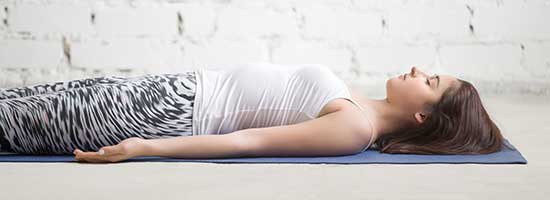
Manage Your Chronic Pain with These Yoga Poses
If you’re among the estimated 100 million Americans living with some type of chronic pain, you know all too well that certain exercises are off-limits, particularly anything excessively strenuous. On the other hand, skipping exercise altogether can weaken muscles and make chronic pain more difficult to manage. For some chronic pain sufferers, yoga can be a happy medium because of its slow, controlled movements. Not all poses are ideal for people with long-term pain. However, the following poses tend to be safer and more effective for individuals with persistent discomfort.
Corpse Pose (Savasana)
This rejuvenating pose is usually the final pose in a yoga class, but it can be a good beginner pose for chronic pain patients as well. It’s performed by lying flat on your back as you let your arms and legs drop. It can also be an effective way to ease the stress that sometimes heightens chronic pain sensitivity since you do slow, controlled breathing as you assume this pose. A rolled blanket or towel can be placed under your knees to make this pose more comfortable.
Inversion Pose
“Inversions” in yoga terms can refer to poses like downward facing dog, the dolphin pose, or wall T-stand. The idea is to turn partially or completely upside down to stimulate your nervous system and boost circulation. But if your chronic pain doesn’t allow you to safely get this flexible, consider a simpler inversion pose. It’s done this way:
- Lie on your back
- Bend your knees and support your legs on a chair’s seat
- Place a rolled towel/blanket under your calves and/or lower back for support
- Slowly inhale and exhale and hold about a minute or two
Supported Back-Bend Pose
You’ll also be resting on your back with this pose. If lying directly on the floor is uncomfortable or triggers pain, consider using a yoga mat. Placed rolled up towels or blankets under three areas: your knees, neck, and shoulder blades. Keep your arms at your side as you extend your legs. Inhale and exhale as you hold the pose for a few minutes.
Figure 4 Pose
If you’re able to try something a bit more involved, consider the figure 4 pose. Lie on your back with your feet hip-width apart. Put one ankle on the opposite knee and flex your foot. Lift the knee that’s supporting your ankle up towards your chest. If you can do so, reach between your legs to the back of the thigh on the leg with the raised knee. Hold the position briefly and switch sides.
Before starting any type of exercise routine, check with your doctor first. If yoga isn’t right for your type of chronic pain condition, you may benefit from water-based exercises or activities. The same muscle groups are worked, but the naturally buoyancy of the water eases stress on your joints, bones, and soft tissues. Some chronic pain sufferers also see positive results with Tai Chi, hot yoga, or Pilates.

